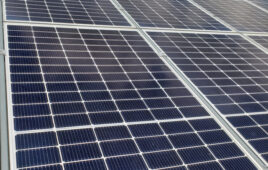According to data from the Federal Energy Regulatory Commission (FERC), solar provided 49.3% of new domestic generating capacity in 2023 in the United States, more than any other energy source. Solar capacity additions in 2023 were 50% greater than the year before. In total, solar added 18,356 MW to the grid in 2023. Comparatively, natural gas added 11,024 MW and wind added 6,356 MW.
The SUN DAY Campaign recently reviewed FERC’s “Energy Infrastructure Update” report and also found that solar capacity additions in December 2023 alone set a new monthly record — 4,979 MW — and accounted for 57.1% of new capacity place into service in the last month of 2023. That was more than double the previous monthly record of 1,982 MW set just the prior month.
For the full 12 months of 2023, renewables provided more than two-thirds (67.2%) of all new generating capacity, trailed by natural gas (29.6%) and nuclear power (3.0%). There were small contributions from oil (64 MW), geothermal (48 MW), biomass (35 MW), and waste heat (31 MW). No new coal capacity was reported.
The latest capacity additions have brought solar’s share of total available installed generating capacity up to 7.9%, tying that of hydropower. Wind is currently at 11.7%. With the inclusion of biomass (1.2%) and geothermal (0.3%), renewables now claim a 29% share of total U.S. utility-scale generating capacity.
For perspective, at the beginning of 2023, solar’s share was 6.4% while wind and hydropower were 11.4% and 8% respectively. The mix of all renewables totaled 27.3%.
If the growth trends of 2023 continue, installed utility-scale solar capacity should exceed that of nuclear power (8%) within the next few months.
Solar capacity is also likely to exceed the individual capacities of both wind and coal within the next three years.
FERC reports that “high probability” additions of solar between January 2024 and December 2026 total 87,098-MW — an amount more than triple the forecast net “high probability” additions for wind (24,495 MW), the second fastest growing resource. FERC also foresees 565 MW of hydropower growth as well as 1,100 MW from the Vogtle-4 reactor in Georgia while coal, natural gas, and oil are projected to contract by 21,911 MW, 3,266 MW, and 2,049 MW respectively.
The numbers for solar may prove to be conservative. FERC reports that there may actually be as much as 218,929 MW of net new solar additions in the three-year pipeline in addition to 75,552 MW of new wind and 7,727 MW of new hydropower. By contrast, net new natural gas additions total only 10,855-MW.
If just the current “high probability” additions materialize, by the end of 2026, solar will account for almost one-seventh (13.7%) of the nation’s installed utility-scale generating capacity. That would be more than either coal (13.6%) or wind (12.8%) and substantially more than either nuclear power (7.6%) or hydropower (7.4%). Solar plus wind will constitute more than three-quarters of utility-scale renewable energy capacity.
However, it should be noted that FERC only reports data for utility-scale facilities (those rated 1-MW or greater) and therefore its data do not reflect the capacity of distributed renewables, notably rooftop solar PV. According to the U.S. Energy Information Administration (EIA), small-scale solar PV is estimated to have accounted for 30.9% of the nation’s electrical generation by solar during the first eleven months of 2023. That suggests that the total of distributed and utility-scale solar capacity combined is significantly more than the 7.9% FERC reported as solar’s share of total capacity at the end of 2023. It is perhaps closer to 11.0% and on track to approach or exceed 18.0% within three years.
It would also bring the generating capacity provided by the mix of all renewables close to – or even surpass – that of natural gas.
In three years, natural gas would still comprise the largest share of installed utility-scale generating capacity (40.9%), down from 43.9% at the end of 2023. However, solar would be in second place while the mix of all renewable sources (i.e., solar plus wind, hydropower, geothermal, and biomass) would total 35.3% of utility-scale capacity, up from 29.0% today.
However, if small-scale solar is factored in, by the end of 2026, renewables could constitute 38.9% of U.S. generating capacity while natural gas’ share would drop to 38.6%. Renewables’ share could be even greater if a larger portion of the solar and wind in the three-year pipeline comes online.
“Solar ended 2023 by setting a record-high number of installations in December and providing half of the nation’s new generating capacity for the year while pulling even with hydropower,” noted the SUN DAY Campaign’s executive director Ken Bossong. “Moreover, the mix of all renewable energy sources appears to be on track to soon surpass the generating capacity of natural gas while solar alone will have more generating capacity than coal, wind, or nuclear power.”
News item from SUN DAY






Kelly,
Since nameplate does not relate very well to actual production I would have like to see how many MWh were in each category. Maybe they have to be for a prior year but to get an actual value but they should be included to help understand the actual production value.